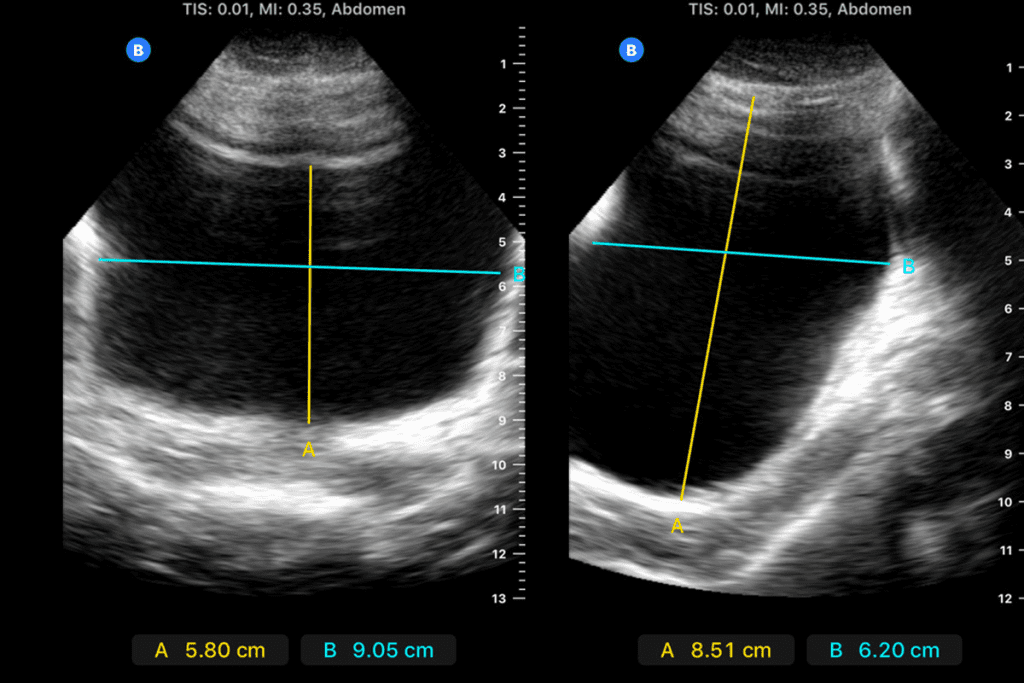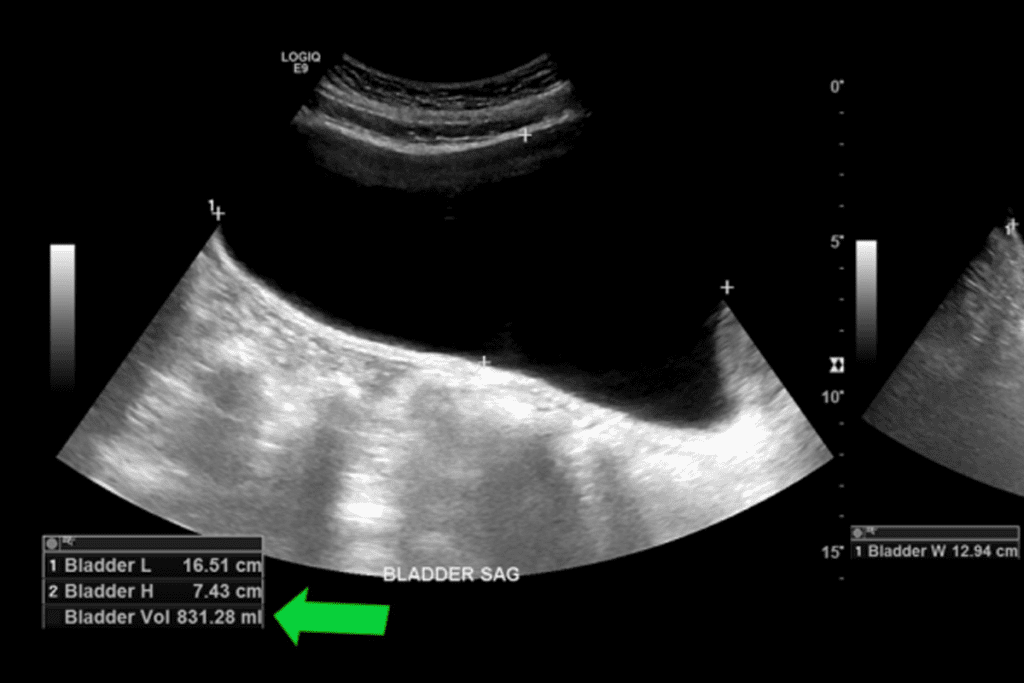Last Updated on November 25, 2025 by
Knowing the normal amount of post-void residual (PVR) urine is key to checking urinary health. At Liv Hospital, we stress its role in spotting urinary retention and other issues.
A post-void residual urine volume under 50 mL is normal for adults under 65. For those over 65, it’s under 100 mL. If you have more, it could mean urinary retention or other problems.

Urinary health is a personal matter, and our team at Liv Hospital treats it with care. Our urology department can diagnose and treat many urinary issues. We make sure patients get all the support they need.
In urology, PVR is key. It measures the urine left in the bladder after we pee.
Post-Void Residual (PVR) is a tool for checking bladder health. It helps find problems like neurogenic bladder and urinary infections.
PVR is the urine left in the bladder after we pee. It shows if our bladder is working right. If it’s not, we might need to see a doctor.
PVR is important for diagnosing and treating urinary issues. It helps doctors figure out the best treatment for problems like not being able to pee.
PVR measurements are key for diagnosing bladder problems. They help doctors spot issues like:
Doctors use PVR to plan the right treatment. This might include more tests, medicine, or other treatments.
Understanding PVR is essential for urological health. It helps doctors give better care. This improves patients’ lives and health.
Knowing normal post-void residual (PVR) values is key for diagnosing and treating urological issues. PVR shows how well the bladder works. It’s a big part of checking bladder health.

Adults under 65 usually have lower PVR values than older adults. A PVR of less than 50 mL is often seen as normal for this age. But it’s important to look at each person’s situation and health when checking PVR.
Recent studies have shown the need for age-specific normal values to correctly understand PVR results. For example, a study in a well-known urology journal found that PVR up to 100 mL might be normal for some under 65. This depends on health and bladder function.
Adults over 65 can have higher PVR values because of age-related changes. A PVR of less than 100 mL to 150 mL is often okay, based on health and other factors. But higher values in older adults might mean there’s a urological problem that needs looking into.
“The 95th percentile of normal PVR for men is approximately 103 mL and 94 mL for women,” according to recent research findings from 2023. This data shows the importance of looking at gender when checking PVR.
The 2023 study on gender-specific PVR values has given us new insights. It found that the 95th percentile for normal PVR is about 103 mL for men and 94 mL for women. This shows that while there are some differences, they are not huge.
This research is very important for doctors. It helps them make better diagnoses and treatment plans. By knowing these gender-specific values, doctors can be more accurate and effective.
It’s important to know when bladder volume is too high. This helps us spot urinary retention problems early. We look for specific levels that show health risks and what causes them.
PVR values between 100 mL and 200 mL are borderline. They mean the bladder isn’t emptying fully. This can cause infections or other problems. It’s key to watch these values closely to avoid more issues.
A bladder volume calculator helps doctors figure out PVR accurately. It’s great for checking bladder function in patients with retention symptoms.

A PVR over 200 mL means the bladder isn’t emptying properly. Values over 300 mL show clear urinary retention. These important levels need quick medical help to avoid damage.
People with high PVR might pee a lot, have weak flow, or have trouble starting. It’s important to deal with these symptoms fast.
Some risk factors make us worry more about bladder volume. Conditions like diabetes or spinal cord injuries can mess with bladder function. Also, blockages like BPH can raise PVR levels.
Knowing these risks helps doctors treat urinary retention better. By spotting these risks, we can act quickly to stop problems.
If you have urinary retention symptoms or are at risk, see a doctor. They can check you out and help.
It’s key to know how we measure post-void residual for good urological care. Getting the PVR right is vital for spotting urinary retention and checking how well the bladder works.
Bladder scan tech has changed how we check post-void residual volume. This method uses ultrasound to guess how full the bladder is. It’s quick and doesn’t hurt. Bladder scans are great for first checks and for people who need to be checked often. The ultrasound technology lets us get the measurements right without needing to use a catheter.
Non-invasive methods are good for first checks, but catheterization is the best for exact PVR measurements. It involves putting a catheter in the bladder to drain and measure the leftover urine. This method is best when you really need to know the exact amount, like before surgery or for certain urological issues. It’s more invasive, but it gives a direct PVR measurement.
Getting the bladder volume right is key for good PVR measurements. Bladder scan tech uses ultrasound images to figure out the volume. For catheterization, the volume is measured directly. It’s important to follow the right steps and use the right tools to get it right. Accurate calculation of bladder volume is essential for making the right diagnosis and treatment plan.
We use these methods to make sure our patients get the best care. By mixing advanced tech with precise measurement methods, we offer full care for urinary issues.
It’s important to know why PVR test results might be high. High PVR test results can mean there’s a problem with how the bladder works. We’ll look at what can cause these high results, which might show issues with the urinary system.
Neurological issues can really mess with bladder function, causing high PVR test results. Problems like spinal cord injuries, multiple sclerosis, and diabetes can harm the nerves that control the bladder. This can lead to trouble emptying the bladder, causing high PVR numbers.
For more on how these conditions affect the bladder, check out NCBI’s resource on neurogenic bladder.
Obstructions in the urinary tract can also cause high PVR test results. Issues like an enlarged prostate, urethral strictures, or bladder stones can block urine flow. This makes it hard to empty the bladder fully, leading to high PVR numbers.
Some medicines can make it hard to urinate, causing high PVR test results. Medications with anticholinergic properties, like some antidepressants and antihistamines, can mess with bladder muscle contractions. This can lead to not emptying the bladder fully. It’s key to talk to your doctor about your meds if you’re seeing high PVR numbers.
As we get older, our bladder can change, leading to high PVR test results. The bladder muscle can get weaker, and the bladder might not empty as well. Conditions like benign prostatic hyperplasia (BPH) in men can also cause trouble. It’s important to understand these changes to keep the bladder healthy as we age.
Abnormal PVR measurements can affect your health and happiness. They can lead to serious problems, making life harder and raising the chance of urinary tract issues.
High PVR levels mean you’re more likely to get urinary tract infections (UTIs). Not emptying the bladder fully lets bacteria grow, causing infections. UTIs can make you feel uncomfortable and hurt, and if not treated, can get worse.
High PVR levels can also harm the upper urinary tract. Not emptying the bladder fully can put too much pressure on the urinary system, damaging the kidneys over time. It’s key to watch and manage PVR levels.
Abnormal PVR levels can really affect your life. Symptoms like needing to pee a lot, feeling urgent, and leaking can mess up your day. Managing PVR well is key to a better life.
Healthcare providers need to understand the risks of abnormal PVR measurements. This helps them take better care of patients, lowering the chance of problems and improving health outcomes. We stress the need for regular PVR checks and management to keep the bladder healthy and overall well-being good.
At Liv Hospital, we follow international best practices for Post-Void Residual (PVR) assessment and management. This ensures our patients get the best care. We stick to global guidelines to offer evidence-based treatment options tailored to each patient’s needs.
We use non-invasive bladder scan technology and catheterization to measure PVR accurately. Our protocols aim for precise measurements. These are key for diagnosing and managing urological conditions well.
Our team of urology specialists works together to assess and manage PVR. We consider age, gender, and medical conditions to offer personalized care. Our focus is on delivering high-quality, patient-centric services.
Liv Hospital provides various treatments for abnormal PVR measurements. These include behavioral therapies, medication management, and advanced surgical interventions. We aim to improve patient outcomes and quality of life.
By using international best practices in our PVR assessment and management, we ensure our patients get the best care. This care is both effective and compassionate.
Proper PVR monitoring is key for a healthy bladder. It helps spot urinary retention issues early. At Liv Hospital, we stress the need for accurate PVR checks in diagnosing and treating urological problems.
Our advanced technology allows for precise PVR measurements. This helps doctors detect bladder issues and create effective treatment plans. It also improves life quality and lowers the risk of infections and damage.
We suggest regular PVR checks, mainly for those with neurological issues, mechanical blockages, or age-related bladder changes. By focusing on bladder health through PVR monitoring, people can keep their bladder functioning well and stay healthy overall.
Post-void residual (PVR) urine volume is the urine left in the bladder after you pee. It helps us check how well your bladder works. We use it to find out if you have urinary retention or other bladder problems.
Normal PVR values change with age and gender. For adults under 65, a PVR under 50 mL is normal. For those over 65, up to 100 mL is okay.
We measure PVR with non-invasive bladder scans or catheterization. Bladder scans are usually preferred because they’re easy and accurate.
Risk factors include neurological conditions, urinary tract blockages, some medications, and age-related bladder changes.
Abnormal PVR measurements can mean a higher risk of urinary tract infections. They can also lead to upper urinary tract damage. This can greatly affect your quality of life and daily activities.
To accurately calculate bladder volume, use the formula: Bladder Volume = (Height x Width x Length) x 0.52. This is done with ultrasound or bladder scan technology.
Common causes include neurological conditions, mechanical obstructions, medication side effects, and age-related changes.
At Liv Hospital, we follow proven protocols for PVR evaluation. We offer advanced treatments tailored to each patient’s needs.
Proper PVR monitoring is key for early detection and management of urinary retention and other bladder issues. It helps prevent complications and improves your quality of life.
Subscribe to our e-newsletter to stay informed about the latest innovations in the world of health and exclusive offers!